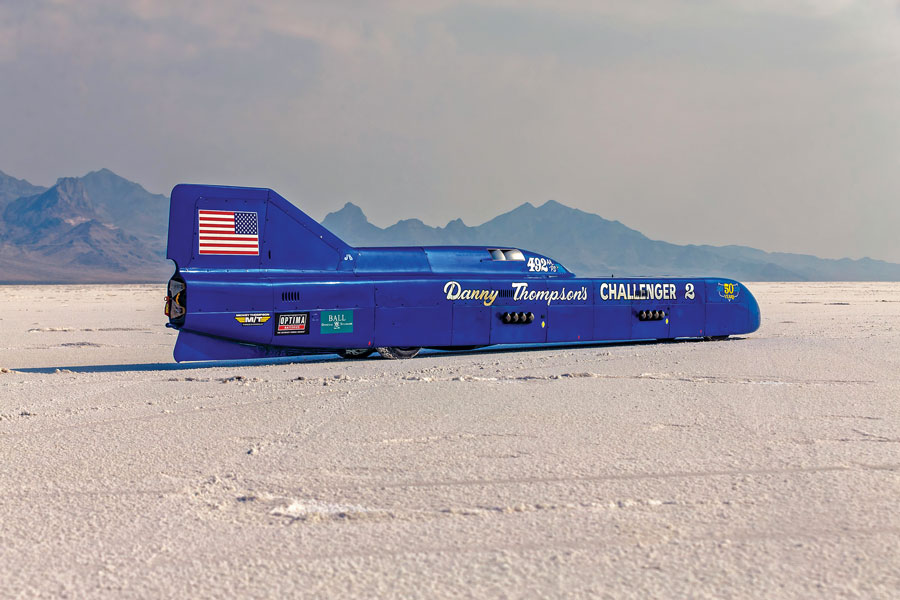- Holds the fastest-ever certified speed-record run for a piston-driven vehicle
- Designed by Hall of Fame driver Mickey Thompson in collaboration with Kar Kraft in 1968
- Driven by Danny Thompson to a new SCTA AA/FS record of 448.757 mph on August 12, 2018, at the Bonneville Salt Flats
- Chassis built by famed Indy Car constructor Quin Epperly with MT Advanced Engineering team and overseen by drag racer Pat Foster
- Restored, retrofitted and updated over seven years by Danny Thompson in his Huntington Beach, CA, shop
- Four-wheel-drive
- Twin Brad Anderson 500-ci dry block A-fuel-type Hemi V8 engines
- B&J Big Boy twin 3-speed transmissions
SCM Analysis
Detailing
| Vehicle: | 1968 Challenger 2 Streamliner |
| Years Produced: | 1968 |
| Number Produced: | One |
| SCM Valuation: | $561,000 (this sale) |
| Tune Up Cost: | $500-plus |
| Alternatives: | Any land-speed racing car with standing records |
| Investment Grade: | B |
This car, Lot S130, sold for $561,000, including buyer’s premium, at Mecum’s Kissimmee, FL, auction on January 11, 2020.
When you buy a race car, you have to consider where you’ll be able to drive it. How far is it to the nearest drag strip, road course or circle track? When you’re buying the world’s fastest piston-powered vehicle, there’s really only one place you can get it up to speed: the Bonneville Salt Flats in Utah. But if your goal is to break 450 mph and set a new world record, that’s your place and the Challenger 2 is your ride.
Not your ordinary hot rod
The Challenger 2 is a purpose-built land-speed-record streamliner. It doesn’t even look like a car, but rather seems to be an experimental airplane that lost its wings. The car was originally designed and built by the legendary Mickey Thompson (with plenty of help from an array of experts) for the 1968 SCTA Bonneville National Speed Trials — better known as Speed Week. Challenger 2 was a follow-up to the original four-engine Challenger that Thompson drove to a 406-mph world record in 1960. In testing, the Challenger 2 unofficially achieved about 400 mph, but didn’t make an official timed run due to flooding on the salt that year.
The Challenger 2 is just 36 inches wide and 37 inches tall at the canopy, but it’s 32 feet long and perfectly streamlined. It rides on four wheels and carries two 500-ci Hemi V8 engines running on a mix of 87% Nitromethane and 13% methanol. Together, the engines are capable of laying down about 5,000 horsepower. Each engine drives its own 3-speed transmission, and each transmission drives one pair of wheels. The engines are coordinated with a unique Hadley Box governing device, which keeps them in sync during the runs.
The Challenger’s skin is made entirely of hand-formed aluminum panels laid over a tube chassis made of lightweight 4130 chrome-moly steel. Even so, the machine weighs in at a hefty 5,800 pounds when fueled up and ready to race. Interestingly, it weighs only 5,300 pounds at the end of its run, because it burns about 50 gallons of fuel along the way. The tires are special too, made by the Mickey Thompson company to hold together at extreme speed. Normal land-speed-record tires would fly apart from centrifugal force under the Challenger 2.
World-record holder
The Challenger 2 is not a car that just anyone can drive. The slightest error or mechanical failure at speeds above 400 mph is almost certain to be fatal. Mickey’s son Danny Thompson spent seven years prepping the Challenger 2 for a 50th anniversary run and achieved a world-record speed of 448.757 mph in 2018. Bear in mind, that’s the average of two runs in opposing directions. The actual trap speed recorded at the exit of the record run was 459.588 mph.
Making a new land-speed record is not easy. Thompson said that the car tried to kill him twice on his runs. In 2018, Thompson was actually breaking his own previous class record of 406.769 mph set in the Challenger 2 in 2016. He also broke the overall SCTA piston-powered speed record of 437.183 mph and the FIA record of 439 mph, both set by George Poteet in 2013.
Didn’t meet estimate
A car like Challenger 2 doesn’t come to auction very often, if ever. There are only a handful of them, and each one is unique. Buyers for these cars are often museums rather than enthusiasts who seek to break the existing records or collectors who just want to have them. We don’t know who bought the Challenger 2, just that they paid a little more than half the low estimate.
It’s hard to draw any conclusions past the immediate sale at hand. An auction requires two or more buyers willing to bid up the price to get any vehicle up to and past its estimate. Buyers have been shying away from big investments since last summer, although the $3.74 million sale of the “Bullitt” Mustang just the day before at the same auction shows that there are still dramatic exceptions.
For his part, Thompson was upfront about why he was selling. The record-holder told Autoweek, “I made the biggest mistake you can make in motorsports. I borrowed money to go racing.” The 71-year-old Thompson needed the cash from the sale to pay off his debts, and hopefully have a bit left over for retirement. So perhaps there are some broader life lessons to be learned from this sale.
Still, no amount of money can buy the world-record-holder’s hat that SCTA bestowed on Thompson, or the personal satisfaction he surely enjoys from realizing his father’s long-cherished dream.
That’s the thing about world records; they can be surpassed, but they can never be taken away.
(Introductory description courtesy of Mecum Auctions.)
